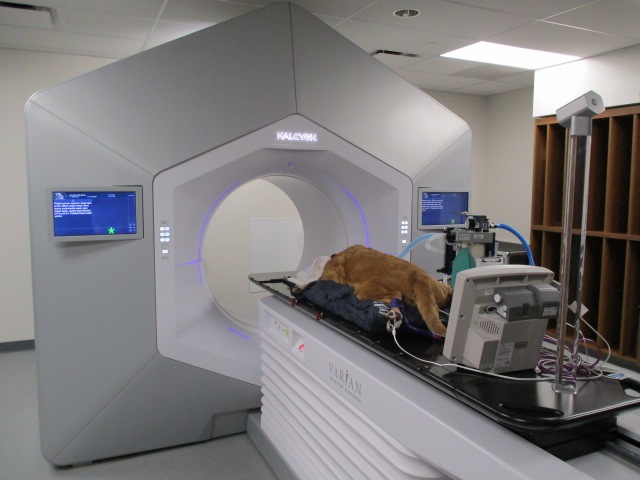
Veterinary medicine has become nearly as progressive as human medicine, and advances in technology allow us to offer pets medical care that is similar to the care available at large, human hospitals. As part of our commitment to providing the most advanced veterinary care available, we regularly update our equipment so pets receive the most modern diagnostics and treatments.
Our oncology department is excited to add a new Halcyon treatment system for radiation therapy. According to the American Veterinary Medical Association (AVMA), 25% of dogs will develop cancer at some point, and almost 50% of dogs over 10 years of age will be affected. Many owners are willing to provide cancer treatment for their pets, and the Halcyon system will allow us to offer more comprehensive treatment plans, in conjunction with surgery and chemotherapy. The Halcyon unit is the most advanced radiation treatment system available for human and veterinary use, and allows us to provide radiation treatments in far less time than typical machines.
Radiation treats cancer by damaging DNA and killing abnormal cells. It is administered as a targeted beam that is focused on a cancerous tumor so nearby tissue is minimally affected. Radiation therapy can be used to shrink tumors prior to removal, slow tumor growth, or to eliminate cancer when surgical removal is not possible.
MRI uses a high-powered magnetic field and radio waves to excite the body’s atoms, which release energy to create an image on a viewing monitor. This advanced imaging modality provides better detail and contrast than X-rays, and creates precise images of specific areas. Although X-rays provide useful images of some body parts, such as bones, soft-tissue structures often cannot be precisely distinguished from surrounding organs. MRI is particularly useful for imaging nervous system structures, such as the brain and spinal cord. Conditions such as brain tumors and spinal cord compression can often be diagnosed more quickly and definitively to allow for prompt treatment.
Unlike X-rays and computed tomography (CT) scans, MRI does not use radiation to generate an image. Anesthesia is necessary during an MRI to keep patients completely still, since the test can take more than 60 minutes. MRI appointments typically last several hours to allow time for anesthetic recovery before your pet returns home.
A ventilator is used to control a patient’s breathing by gently forcing air into the lungs to inflate them. Patients in critical condition may require respiratory support during recovery to maintain adequate gas exchange between the lungs and the bloodstream. Conditions that may require ventilatory support include:
A ventilator administers oxygen to patients through an endotracheal or tracheostomy tube placed in their trachea, which requires anesthesia during therapy. Patients on ventilatory support require intensive care and continuous monitoring, and are hospitalized in the intensive care unit with 24-hour care from veterinary specialists. Our emergency and critical care department allows us to provide the most advanced care available to the sickest, most critical patients.

An ultrasound emits high-frequency sound waves from a probe that is moved over a pet’s skin surface. The sound waves are reflected off tissue boundaries— where muscle and bone meet, for example—and sent back to the probe, where they are transmitted to a viewing screen to create an image. Ultrasound allows veterinarians to view internal body structures in real time to observe their structure and function. Pets typically do not require sedation or anesthesia for an ultrasound procedure.
A cardiac ultrasound, or echocardiogram, allows veterinary cardiologists to view the heart as it pumps so they can evaluate internal chamber size, valve function, blood flow, and structural abnormalities. Echocardiogram is considered the best diagnostic test for heart disease, since it provides non-invasive observation of real-time heart function.
If your family veterinarian refers your pet to Upstate Vet for diagnostic testing or treatment, you can be assured that our recent technological updates will afford her the best veterinary care available. Contact us with questions about our recent technology additions, or to schedule an appointment with any of our specialty departments.